AMD vs. Intel in the 15-Inch Surface Laptop 3: Both Models Benchmarked
Intel and AMD fight on the Surface battlefield.
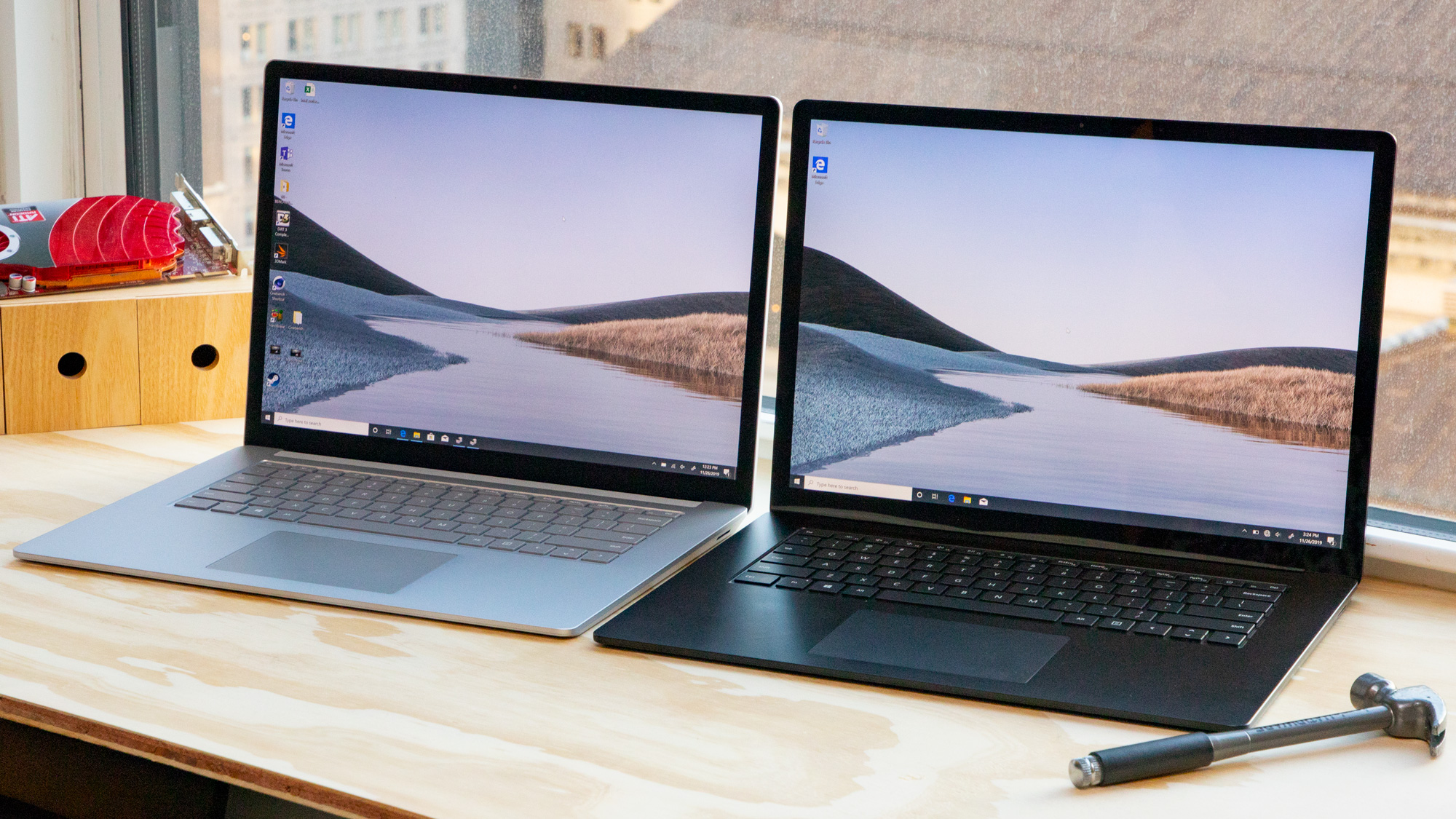
Microsoft dropped a surprise this year when it announced its Surface lineup: the 15-inch Surface Laptop 3 was the first in Microsoft’s arsenal to use AMD’s Ryzen processors.
The 13-inch Surface Laptop 3 stuck with Intel’s Ice Lake processors. Interestingly enough, so did the business model of the 15-incher.
We reviewed the 15-incher with an AMD Ryzen 5 3580U Microsoft Surface Edition CPU, Radeon Vega 9 integrated graphics, 16GB DDR4 RAM and 256GB PCIe NVMe SSD storage.
Now, we have our hands on the business version of the 15-inch Surface Laptop 3, and it’s time to set them face to face to see if AMD is the winner, or if you should find a business version of the 15-inch version of the Surface Laptop.
Specifications
| Header Cell - Column 0 | Microsoft Surface Laptop 3 (15-inch) | Microsoft Surface Laptop 3 for Business (15-inch) |
|---|---|---|
| CPU | AMD Ryzen 5 3580U (Microsoft Surface Edition) | Intel Core i7-1065G7 |
| Graphics | Radeon Vega 9 (integrated) | Intel Iris Plus (integrated) |
| Memory | 16GB DDR4-2400 | 16GB DDR4 RAM |
| Storage | 256GB PCIe NVMe SSD | 256GB PCIe NVMe SSD |
| Display | 15-inch, 2496 x 1664 touch screen with 3:2 aspect ratio | 15-inch, 2496 x 1664 touch screen with 3:2 aspect ratio |
| Networking | Qualcomm Atheros QCA61x4A | Intel Wi-Fi 6 AX201 |
| Ports | USB Type-C; USB Type-A; 3.5mm Headphone jack; | USB Type-C; USB Type-A; 3.5mm Headphone jack; |
| Camera | 720p webcam | 720p webcam |
| Battery | 45.8 Whr | 45.8 Whr |
| Power Adapter | 65W | 65W |
| Operating System | Windows 10 Home | Windows 10 Pro |
| Dimensions | 13.4 x 9.6 x 0.6 inches (339.5 x 244 x 14.7 mm) | 13.4 x 9.6 x 0.6 inches (339.5 x 244 x 14.7 mm) |
| Weight | 3.4 pounds | 3.4 pounds |
| Price (as configured) | $1,699 | $1,799 |
Let’s get this out of the way up top: Yes, it’s a Ryzen 5 vs an Intel Core i7. This was the smallest difference between the two, and getting Intel with an i7 was just $100 more than the AMD model we reviewed. To upgrade to a Ryzen 7, you’d have to pay a minimum of $2,099, so we’re comparing here on price.
Productivity Performance
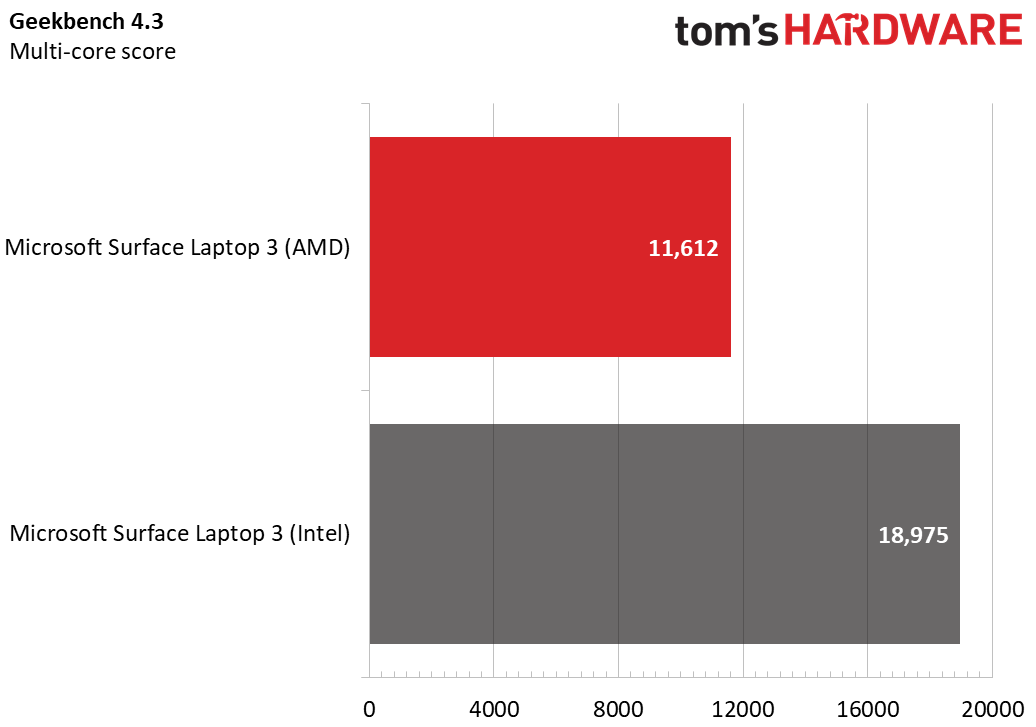
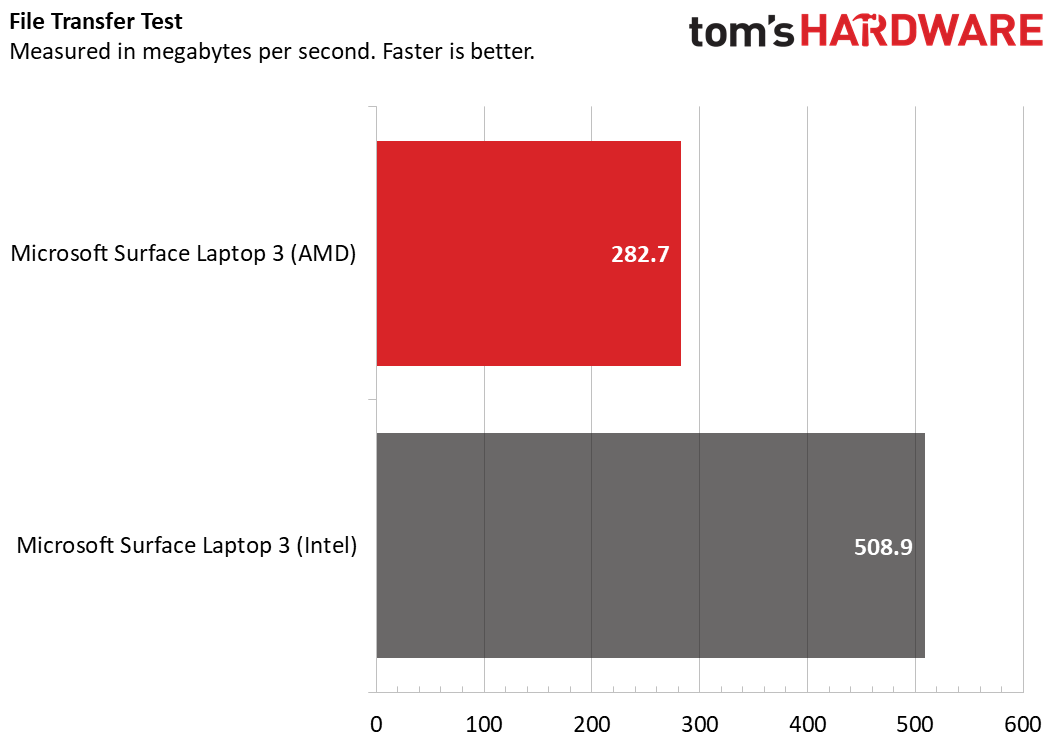
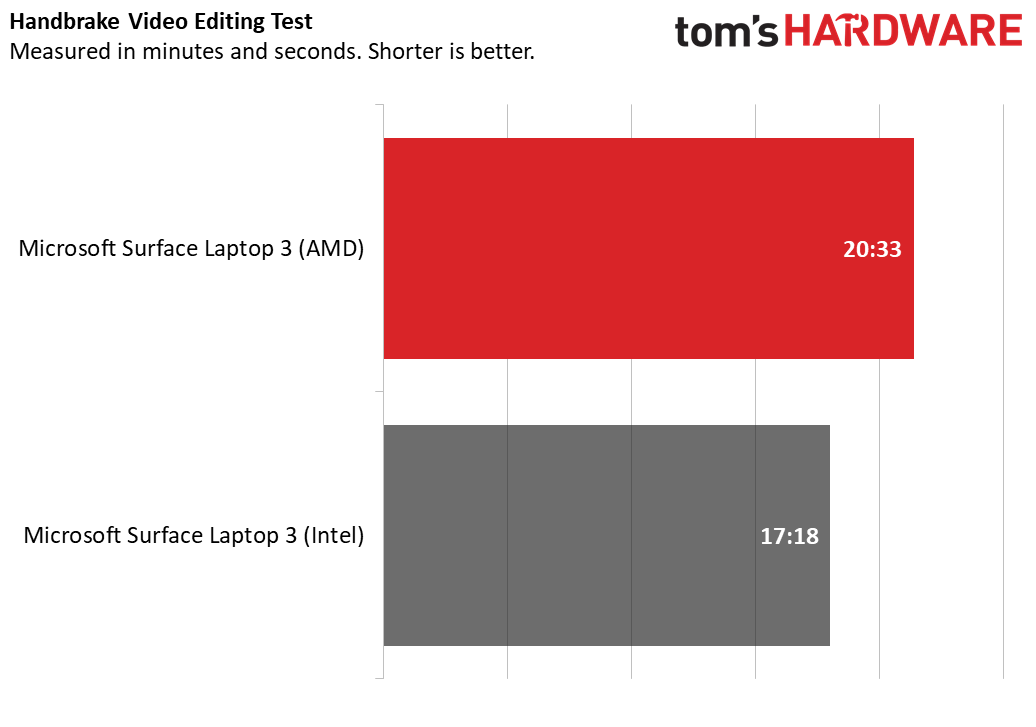
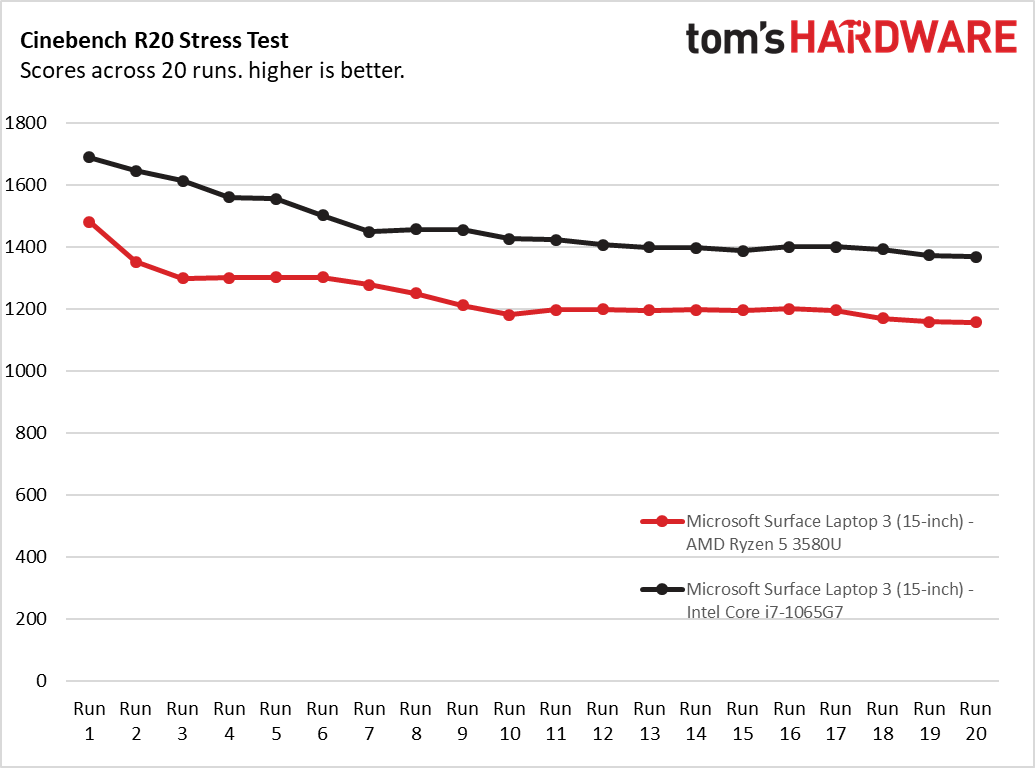
On Geekbench 4.3, the Intel-equipped Surface Laptop 3 earned a score of 18,975. The AMD model hit a lesser 11,612.
The Intel Surface Laptop 3 also won out on the file transfer test. It copied 4.97GB of files in 10 seconds, a rate of 508.9 MBps. The AMD machine reached a slower 282.7MB.s
There might be an explanation for the file transfer scores beyond the processors. It seems that Microsoft is dual-sourcing its SSDs from Toshiba and SK Hynix. The Intel version came with a Toshiba, while the AMD we tested earlier had an SK Hynix drive.
On our Handbrake test, laptops transcode a 4K video to 1080p. That took the Ryzen Surface 20 minutes and 33 seconds, but the Core i7-powered Surface did it more quickly, completing the task in 17:18.
Get Tom's Hardware's best news and in-depth reviews, straight to your inbox.
To stress test productivity laptops, we run Cinebench R20 on a loop 20 times in a row. On the AMD machine, the CPU ran at an average clock speed of 2.5 GHz and an average temperature of 61.5 degrees Celsius (142.7 degrees Fahrenheit). The highest score in R20 was on the first run (1480.4). This dropped slightly around run 3 and then to its lowest range at run 9, ending at its lowest score on the final run (1157.2). It leveled out in the 1100’s around run 9.
On the Intel machine, the CPU ran at an average clock speed of 2.4GHz and an average temperature of 73.3 degrees Celsius (163.9 degrees Fahrenheit). It started higher on Cinebench R20 (1687.7) but didn’t really level out until run 7, when most scores were in the mid 1400’s.
Graphics Performance
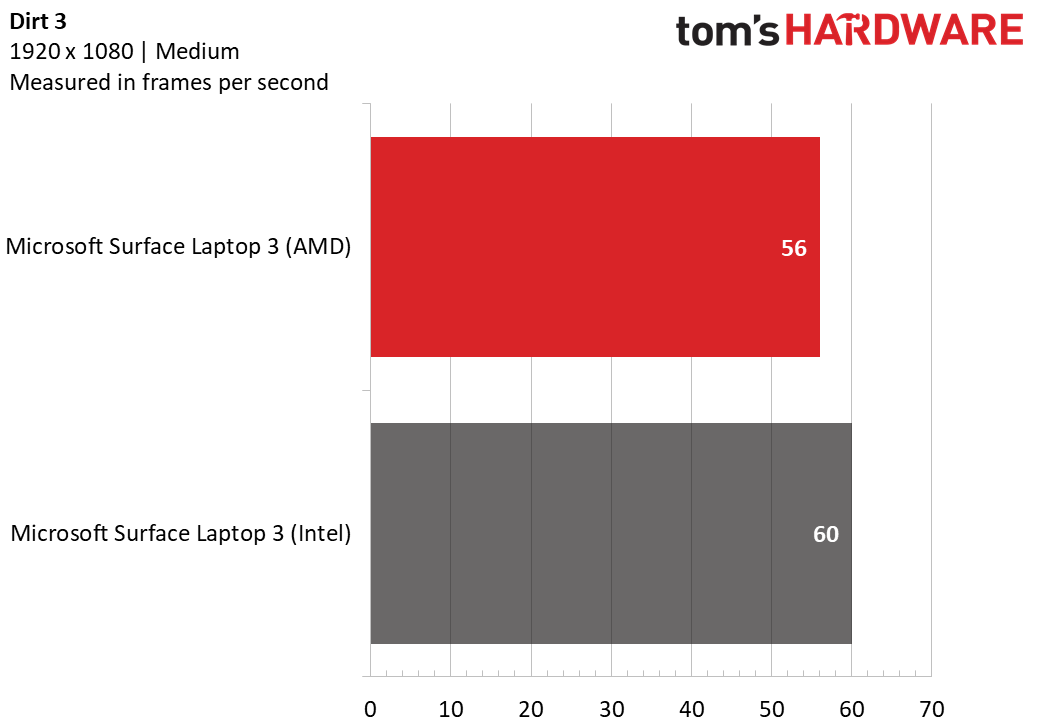
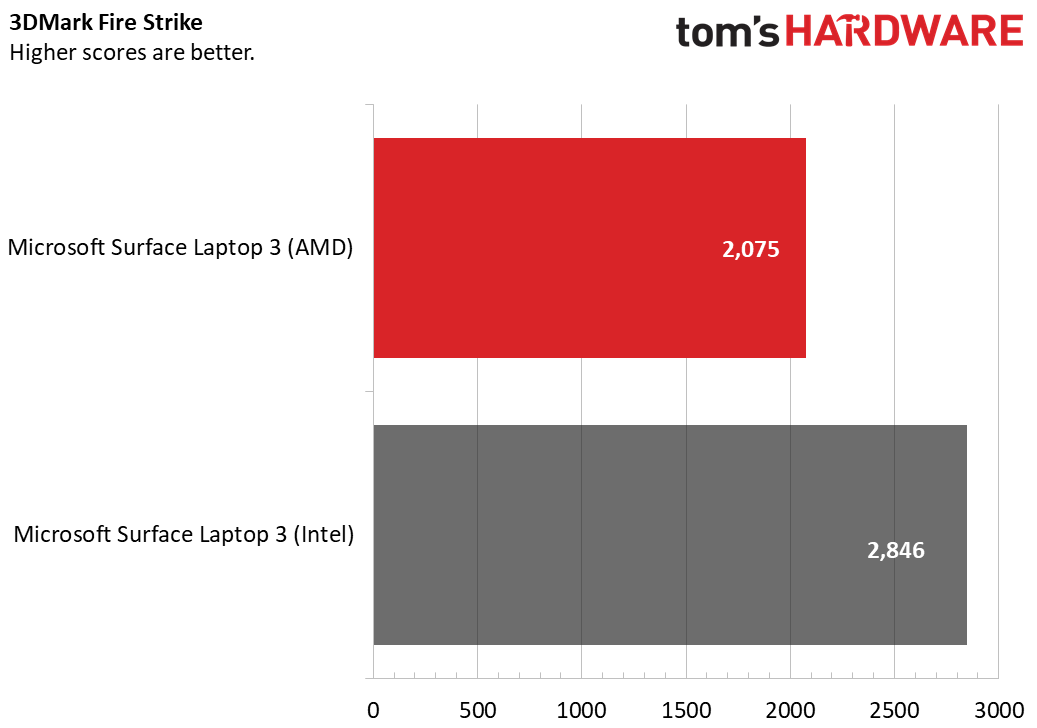
Because neither of these are full-on gaming laptops, we tested graphics with the Dirt 3 benchmark on medium presets at 1080p.
The Intel model ran the benchmark at 60 frames per second, edging out the AMD version, which ran at 56 fps. It’s a slight victory for Intel’s Gen 11 graphics, as the company has often fell far behind AMD’s integrated graphics.
We got similar results on 3DMark Fire Strike, in which the Intel machine earned a score of 2,846 while the AMD laptop hit 2,075.
Battery Life
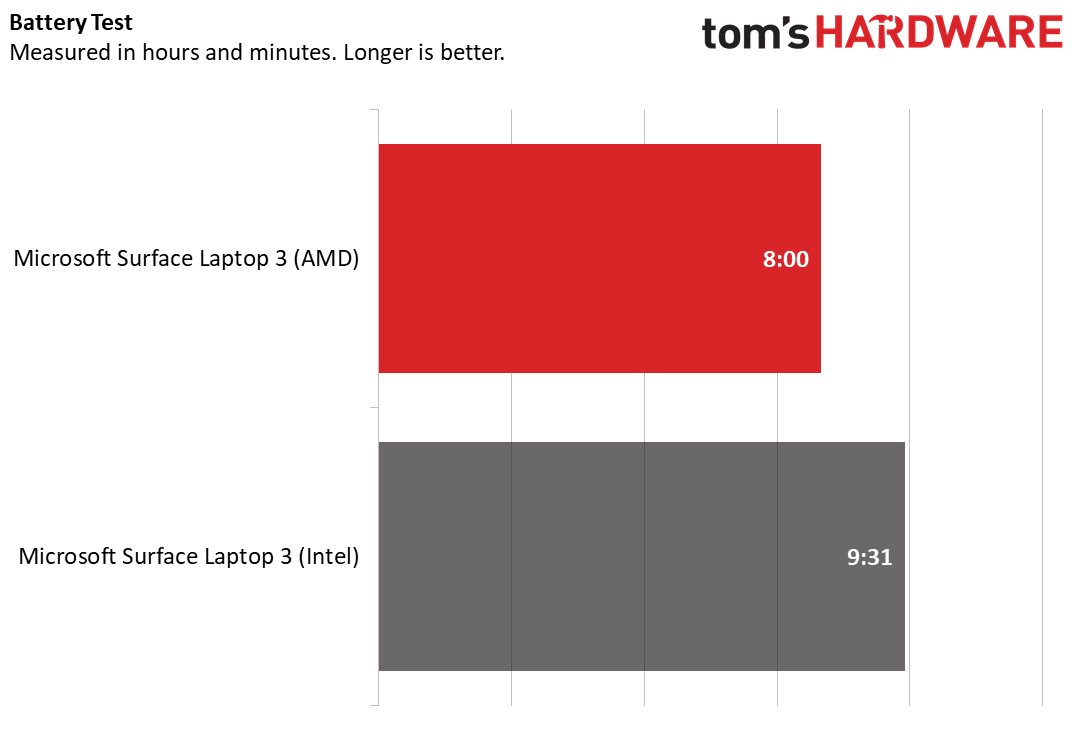
On our battery test, laptops run continuously over Wi-Fi with displays set at 150 nits of brightness. The laptops browse the web, stream video and run OpenGL tests in the browser.
The Surface Laptop 3 with the Ryzen 5 CPU ran for 8 hours flat. The Intel Core i7, however, lasted 9:31.
Other Considerations
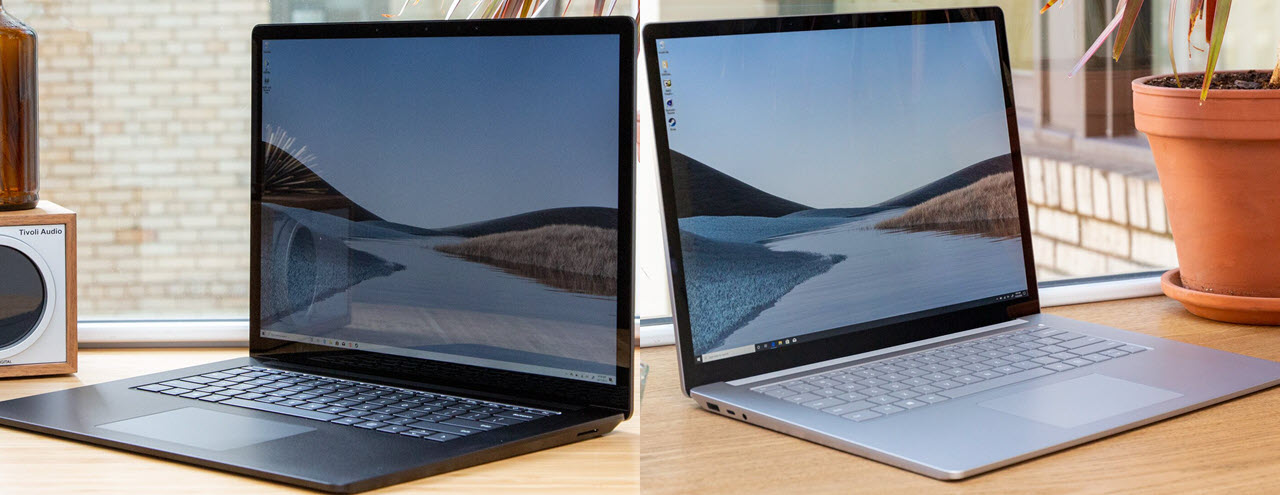
You’ll get the same design and 15-inch, 2496 x 1664 display on either the AMD or Intel Surface Laptop 3. There’s the same ports, including USB Type-A, USB Type-C and Surface Connect. But there are a few little benefits you get with the Intel version that you don’t with the AMD option.
The first is the Wi-Fi card. The consumer-oriented Ryzen options has a Qualcomm Atheros QCA61x4A, which offers 802.11ac Wi-Fi (Wi-Fi 5). Frankly, this will be enough for most people, especially as there are only a few Wi-Fi 6 routers out there.
But the business model has Intel’s own Wi-Fi 6 AX201 card, which allows for 802.11ax (Wi-Fi 6). Most users won’t get the benefit of this, but there is some future-proofing here.
The Intel version comes with Windows 10 Pro, rather than Windows 10 Home on the regular model with AMD.
The Intel version of the 15-inch Surface Laptop 3 goes up to 32GB of DDR4 RAM and 1TB of storage, should you want to configure it that way. The AMD version tops out at 16GB of DDR4 RAM, but offers the same storage options.
If you choose to get the 13.5-inch version, which only uses Intel CPUs, you can also get faster LPDDR4x RAM, but that’s not available at all on the 15-inch laptop no matter which version you get.
If you want more color options, that’s where the AMD model shines. You can get it in the new sandstone metal, cobalt blue with Alcanara and platinum as either all-metal or with Alcantara. But the business version with Intel only comes in black or platinum.
Conclusion
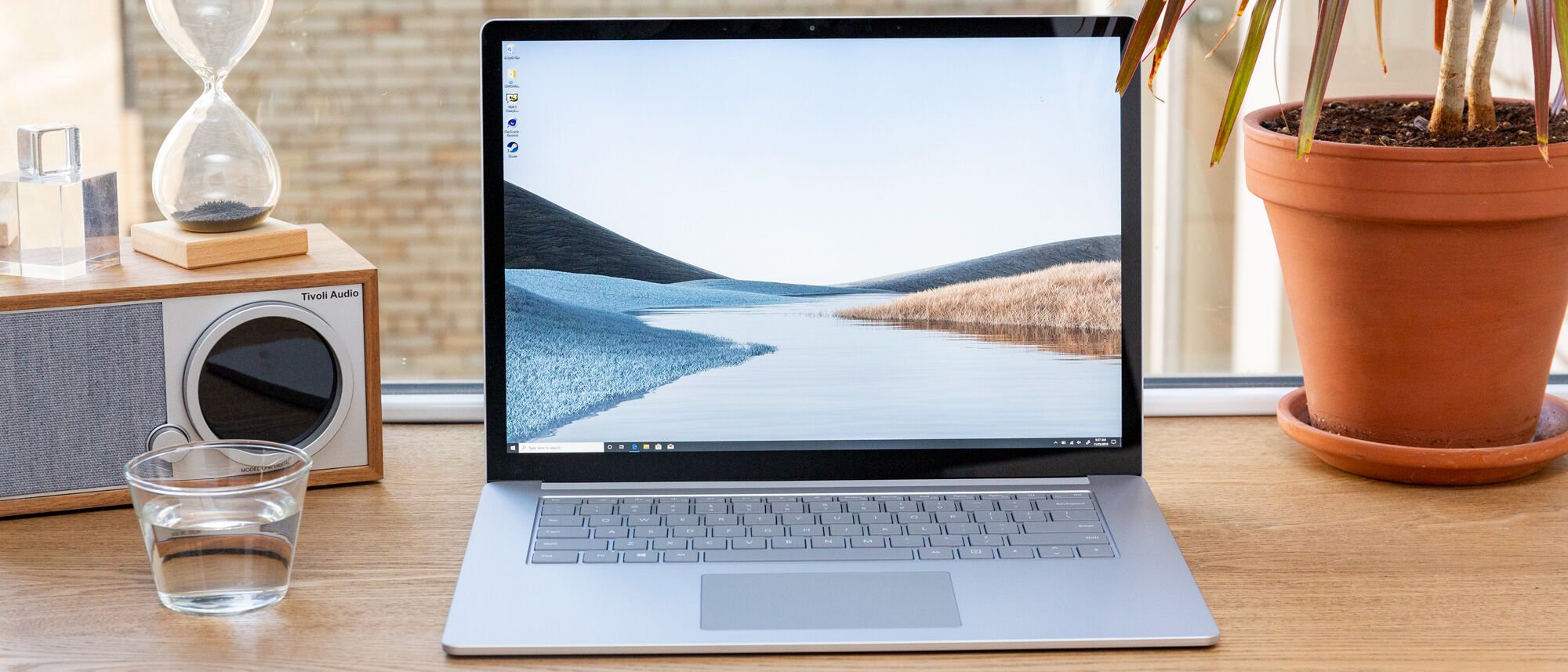
If you want the best 15-inch Surface Laptop 3, you should dig through Microsoft’s website, find the business model, and buy that one. With the Intel Ice Lake CPU inside, it offers more performance and longer battery life than the AMD model we reviewed.
It costs $100 more, but I think that if you can afford it, the price difference is worth it.
We’ve yet to see AMD bring its Zen 2 chips to mobile and in this space, Intel is still dominant.

Andrew E. Freedman is a senior editor at Tom's Hardware focusing on laptops, desktops and gaming. He also keeps up with the latest news. A lover of all things gaming and tech, his previous work has shown up in Tom's Guide, Laptop Mag, Kotaku, PCMag and Complex, among others. Follow him on Threads @FreedmanAE and BlueSky @andrewfreedman.net. You can send him tips on Signal: andrewfreedman.01
-
larkspur Well the $100 is worth it for Win 10 Pro alone... but I wasn't expecting a slaughter-fest when comparing these systems with identically-priced hardware. I also figured that Vega 9 would at least have an edge on Iris Plus. But yeah, clearly until Zen 2 hits mobile, Intel still owns mobile. At least AMD should drop prices to make these current mobile chips competitive. This particula comparison isn't even close!Reply -
alextheblue Why isn't the memory clock listed for the Intel model? Because AnandTech has a chart that seems to indicate LPDDR4X is used in the 15" Intel models too.Reply
https://www.anandtech.com/show/15008/the-microsoft-surface-laptop-3-15-inch-review
The main issue is how these are priced by MS. The Ryzen 7 model should be sold at the same price as the i7, and the Ryzen 5 model should drop accordingly. I think the Ryzen models are just being offered to help deal with the Intel shortages, and for leverage with Intel.larkspur said:Well the $100 is worth it for Win 10 Pro alone... but I wasn't expecting a slaughter-fest when comparing these systems with identically-priced hardware. I also figured that Vega 9 would at least have an edge on Iris Plus. But yeah, clearly until Zen 2 hits mobile, Intel still owns mobile. At least AMD should drop prices to make these current mobile chips competitive. This particula comparison isn't even close! -
alextheblue ReplyIf you choose to get the 13.5-inch version, which only uses Intel CPUs, you can also get faster LPDDR4x RAM, but that’s not available at all on the 15-inch laptop no matter which version you get.
Well turns out this was completely bogus.
AnandTech just did a comparison, the 15 inch Intel models use the much faster memory. This is AMD's fault for falling behind on memory tech, for the record. But it still seems really shady to make it seem like they're on equal footing as far as memory bandwidth is concerned... especially when you don't read comments or bother following up for confirmation of such minor details as DDR4 2400 vs LPDDR4X 3733.
To upgrade to a Ryzen 7, you’d have to pay a minimum of $2,099, so we’re comparing here on price.
This is also a bit misleading. The Ryzen 7 at $2,099 is a 512GB model. The equivalent Intel 512GB model still uses the 1065 but costs $2,199. I have no idea why MS doesn't offer a Ryzen 7 with 256GB of storage. So in Anandtech's comparison, the Ryzen model still gets beat out of it on the CPU side (Zen+) but even with the bandwidth disadvantage, it manages to narrowly stay ahead on the GPU side.